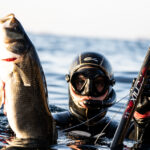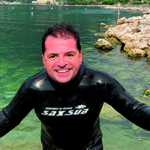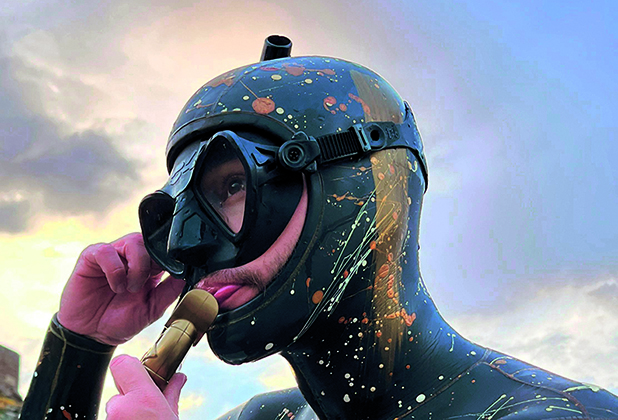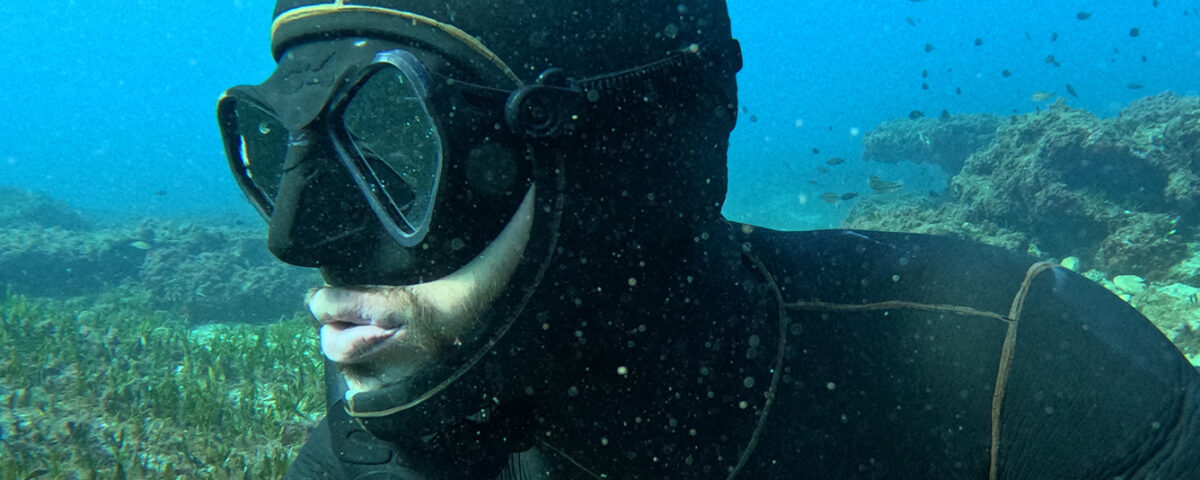C4: Condor Mask

But how much fish at the Palma Master!
19 March 2024
Carlo Altomonte: coach and professor
24 April 2024We tested this brand new model, which showed exceptional visibility and an ultra-reduced internal volume
Jack Cubeddu
In a commercial world now saturated with products, major companies play their best cards to emphasize the quality of existing accessories. Riding on this "underwater revolution," C4 Carbon, one of the most active in the sector, offers a truly unique mask, loaded with innovations and novelties: the new Condor.
It is a Frameless mask, which means that the silicone frame is molded together with the lenses in a single piece, without any rigid or assembled structure.
During our usual unboxing and first "dry" impression, we couldn't help but notice the generous lenses, made of tempered glass, skillfully inserted into a very soft and minimalist frame, rich in details.
The new Condor presents itself as a revolutionary mask in terms of the visual field/internal volume ratio, raising the standard and proposing, in addition to this, a modern and hydrodynamic design, designed by Enrico Sala and C4 Carbon.
But what are the elements that have allowed such a revolution? It all starts with a self-adapting facial skirt that, produced through the study of materials and the space between the frame and the lens, allows the mask to have a semi-rigid structure, capable of adapting to the face without creating visual distortions, maintaining the minimum possible distance between the eye and the lens.
Generous lenses, the right frame inclination, and a minimal internal distance, the perfect combination to generate the best compromise between the visual field and an ultra-reduced internal volume. Currently, the company declares, it is the mask with the best ratio available on the market.
Another factor of primary importance lies in the chosen materials. The Condor is made of a soft hypoallergenic silicone which, through specially studied ribs, visible externally and internally, allows for comfortable fitting and excellent adaptation to the face, without showing any yielding or deformation during use.
The finish of the silicone has been deliberately mattified to avoid possible external reflections and annoying sun refractions inside.
Continuing the analysis of the structure, in the nose area we notice two small but very interesting details. The first is the differentiated thickness at the nostrils, which will favor compensation by facilitating the "pinching" on our nose. The second concerns the shape chosen in the lower part of this area, with a V-shaped invitation useful for accommodating even larger noses.
Another important detail is the double internal edge of the skirt, present along the entire face contour, except for the lower part of the eyes and "mustache". This little gem ensures better sealing, greater comfort, and excellent adherence to the face without the need for excessive strap tension.
And speaking of straps, there are also significant innovations here. Collaboration with Sala has allowed the company to propose on the Condor a new lateral attachment system, called Mps (Morphological Pivoting System). It consists of a tilt of the side clips that allow a better posterior positioning of the strap itself, thus offering greater comfort and prolonged efficiency over time of the frame-clip relationship.
Finally, the rear strap. Made of the same silicone as the frame, it features a convenient snorkel loop and is structured with anti-entanglement technology.
The Condor will be available in the Black version (the model tested), but also in Carbon Look and Camu Med colors. The price will be €55 for the black version and €65 for the two patterns.
In the water
As we were saying, we are facing one of the widest visual fields in the panorama and an extremely reduced volume. For these reasons, the new Condor needed a "super test" to understand its potential and to fully exploit its qualities. A trial fishing on the seafloor would be too limited, while a simple dive to medium/high depths would be too predictable.
I decide to dedicate two different days to the mask; on the first, I will take advantage of a lull in the Maestrale wind to evaluate its visual field, trying to spot fish disturbed by the swell and the "algae salad," while the second day will be dedicated to deeper dives to observe if there is a real compensation advantage due to its reduced internal volume.
But first, a little precaution. The evening before going out to sea, being a veteran in Frameless masks and knowing the "annoying fogging" trap, I decide to perform not one but two lens degreasing treatments: alternating between burning and using a specific spray to remove the silicone oil residue left on the lens during the final production phase.
In the Shallows It's a cold January afternoon, and the few hours of afternoon light allow me a brief getaway to catch a couple of sea bream for dinner. The conditions are right, both for fishing and for testing the new Condor in a simple but particular context. In fact, despite the Sardinian crystal-clear water, the rough sea has "combed" several areas of algae, bringing a large amount of dead algae to the seafloor. The ideal testing ground to notice the arrival of prey before they notice us.
Fully geared up, I finally put on the new Condor. The micrometric adjustment of the buckles allows me a perfect tightening of the strap, which, without any particular tension, ensures an excellent seal of the mask on the face.
Finally in the water! The very first sensation is quite peculiar. The wave that tosses you and the ability to see so much and so well create a pleasant sensation, but to describe it best, it could be defined as a mix between disorientation and astonishment.
The habit of masks with closed spaces and with a classic visual field, where the structure covers the eye's vision at various points, can lead to disorienting effects when trying products that offer such a wide visual field, to which our eye is not accustomed. I experienced the same effect when the first frameless masks came out, and I still remember when I wore one for the first time and had the same sensation for a few seconds.
Once the effect, which we can define as a "pleasant amazement," passed, my vision adjusted to this new perspective, and we were ready to really start fishing.
The wave is really strong, almost ripping the mask off the face. But the excellent design work done on the Condor allows for an excellent fit on the facial contour, and there is no shifting or loosening even when the wave hits and we are hit by the current return. It's as if the silicone and ribs absorb the disturbances.
As I suspected, the fish find it easy to hide in the dead algae, where especially the sea bream like to hide to facilitate hunting. In turn, I must be quick to identify the prey and bring them within range before they notice my presence.
In this case, the Condor makes my job easier. The wide visual field undoubtedly plays a fundamental role, allowing me, especially on the sides, to spot the approach of prey well in advance and to exploit this advantage.
The two hours of light granted after work quickly pass, and it's time to return to solid ground.
In this first test phase, the new Condor passes with flying colors, showing a visual field that has allowed me on at least four occasions to outsmart some sea breams that, amidst the dead algae, the white of the swell, and the twilight, were playing hide-and-seek.
Particularly noteworthy is the sensation experienced on the first entry when the eye, accustomed to the old spaces and the limits conditioned by the structure of the mask used until the day before, found itself with a new vision and had to become familiar with these new spaces, creating a peculiar sensation that lasted a handful of seconds.
In the Mid and Deep Waters
Another outing, another test. This time I treat myself to a half-day of dives to the reef, on a variable depth between fifteen and twenty-five meters. I want to make a further assessment of the visual field but, above all, understand if the internal volume facilitates better equalization, and what other benefits the Condor can bring.
Unlike the first entry, my eyes have already become accustomed to this new perspective, so I immediately feel at ease. I start a series of dives within fifteen meters, where the mask offers me the advantage, as in the first instance, of an excellent visual field.
Without moving or rotating my head excessively, I can get a great overview of the situation, observing with long glides everything around me or the movement of some prey nearby. What surprises me is how, despite the strap not being excessively taut, the Condor still manages to maintain an excellent seal on the face, undoubtedly due to the softness of the silicone and the double edge, which, like a suction cup, keeps the mask securely in place.
I prepare for a dive to twenty-six meters, on some known rocks where whitefish usually linger, but which could also hold a few surprises.
Despite my Hands-free equalization, I still decide to do it manually, so I can evaluate the ease of pinching the nose. The mask has such a reduced internal volume that I hardly notice the air used to equalize it, and reaching the nostrils during the dive is quick and easy. As if there were no thin layer of silicone separating my fingers from my nose.
The meters pass, and under the fins, once I reach the bottom, I notice a movement of tails slipping to the right, just behind a boulder. It's a school of big sea bream.
I accelerate the maneuver to prevent them from retreating into the burrow, and with two specimens aligned, I take the shot, attempting a pair. Luck and preparation go hand in hand, allowing me to make the best of a beautiful catch, which kicks off the day.
The excellent visual field of the mask allowed me this time too to spot the movement of the fish in advance, anticipating their moves, while its reduced volume made equalization easy and with minimal effort.
After several hours in the water and after bringing in a few more specimens and thoroughly testing the Condor, it's time to return and draw the usual conclusions from the test.
As I take off the mask, there is only a light mark on my face, despite the many hours at sea, a sign of the excellent work done in choosing materials and designing the frame.
Silicone as rigid as and where it needs to be, but that offers exceptional comfort around the face, which probably, given the anatomy and softness of the structure, will fit well to most faces that try it on.
The visual field/internal volume ratio is excellent, offering visibility well beyond the standards for lovers of the seafloor, who must be ready to anticipate the prey that can suddenly appear, as well as for those who decide to use it for deeper dives, ensuring a product that not only requires minimal equalization but also provides excellent visibility at great depths.
In short, it's truly an excellent mask, certainly a reference on the market.
To the Ratings!
Ergonomics 9
Exceptional fit thanks to the choice of excellent materials and a structure that accommodates the face well, facilitating use. To top it off, the Mps system, combined with an excellent strap, makes the Condor super comfortable.
Internal Volume 9.5
The new Condor has one of the lowest internal volumes on the market. A feature that, when compared to its field of view, makes it unique in its kind.
Construction Quality 9
The choice of the best silicone, carefully structured to create a mask that is soft to the touch and easy to wear, but rigid where and when needed, allows for optimal face adaptation without compromising vision and usability.
Field of View 10
Exceptional. Image clarity such that it seems like you've seen the seabed in HD.
Design 9
Enrico Sala's touch has brought freshness to the design. Not only a highly hydrodynamic profile but also a series of truly useful details, such as the Mps system attachments, the double edge, or the differently thickened nose.
Quality/Price Ratio 7.5
The price is in line with masks of the new generation, although it must be recognized that, to date, the Condor offers unique features.



